List of emperors of the Song dynasty

The Song dynasty (960–1279) was an imperial dynasty of China that succeeded the period referred to as Five Dynasties and Ten Kingdoms period (907–960) and preceded the Yuan dynasty (1271–1368), which conquered the Song dynasty in 1279. The conventional division into the Northern Song dynasty (960–1127) and Southern Song dynasty (1127–1279) is created by the conquest of northern China by the Jin dynasty (1115–1234) in 1127 and the consequent shift of the capital from Bianjing (present-day Kaifeng) in the north to Lin'an (present-day Hangzhou) in the south.
Below is a complete list of emperors of the Song dynasty, including their temple names, posthumous names, given names, and era names. The dynasty was founded by Zhao Kuangyin, who became Emperor Taizu (r. 960–976) and concluded with the death of Zhao Bing (r. 1278–1279). The last emperor of the Northern Song was Emperor Qinzong (r. 1126–1127), while the first Southern Song emperor was Emperor Gaozong (r. 1127–1162).
The emperor, or huangdi, was the supreme head of state during the imperial era of China (221 BC – 1912), including the Song dynasty. He was a hereditary ruler who shared executive powers with civilian officials appointed to various levels of office according to their performance in bureaucratic examinations. The growing importance of the civilian bureaucracy and national gentry class during the Song dynasty led to a much more limited role for the emperor in shaping public policy, although he still maintained his autocratic authority. He had the sole right to establish new laws, although he was expected to respect legal precedents set forth by previous emperors of his dynasty.[1]
Background


Right image: Portrait of Emperor Shenzong (r. 1067–1085) by an anonymous Song artist
The Song dynasty was founded by Zhao Kuangyin (Emperor Taizu) (r. 960–976) in 960, before the Song completely reunified China proper by conquest—excluding only the Sixteen Prefectures. The Song fought a series of wars with the Liao dynasty (1125–1279), ruled by the Khitans, over the possession of the Sixteen Prefectures of northern China.[2] The Liao regime was toppled in 1125 in a joint conquest by Song forces and the Jurchens led by Wuqimai (Emperor Taizong) (r. 1123–1134). However, the Jin quickly turned against the Song and invaded Song's northern territory.[2] In what is known as the Jingkang Incident,[3] Jin forces captured the Song capital, Bianjing (present-day Kaifeng), in 1127, along with Emperor Huizong (r. 1100–1126), then a retired emperor, and his ruling son Emperor Qinzong (r. 1126–1127).[4]
Emperor Gaozong (r. 1127–1162), a son of Emperor Huizong, fled south and reestablished the Song dynasty at what is now Nanjing.[5] He established a temporary capital at Lin'an (present-day Hangzhou) in 1129, yet by 1132 he declared it the official capital of the Song Empire.[6] The Jin made several failed attempts to conquer the Southern Song, but in 1165 Emperor Xiaozong of Song (r. 1162–1189) and Emperor Shizong of Jin (r. 1161–1189) agreed to a peace treaty that resulted in a diplomatic accord being reached between the two empires.[7] The Song continued to rule southern China until 1279, when the Yuan dynasty led by Kublai Khan, the Khagan of the Mongols,[8] invaded and conquered Song. The last ruler was Zhao Bing (r.1278–1279), who was killed on 27 March 1279 during the naval Battle of Yamen in what is now modern Yamen Town in Xinhui District, Jiangmen City, Guangdong Province.[9][10]
Titles and names
From the Qin dynasty (221–206 BC) until the Qing dynasty (1644–1912), the ruling head of state was known as huangdi, or emperor.[11] In Chinese historical texts, emperors of the Song dynasty, along with the Tang and Yuan dynasties, are referred to by their temple names.[12] Before the Tang dynasty (618–907), emperors were generally referred to in historical texts by their posthumous names.[12] During the Ming (1368–1644) and Qing dynasties, emperors were exclusively referred to in historical texts by their single era name, whereas emperors of previous dynasties, including the Song, usually had multiple era names.[13] The amount of written characters used in posthumous names grew steadily larger from the Han dynasty (202 BC – AD 220) onwards and thus became overly long when referring to sovereigns.[12] For example, the posthumous name of Nurhaci (r. 1616–1626), the founder of the Manchu state which would eventually establish the Qing dynasty, contained 29 written characters.[12] By the Tang dynasty, much shorter temple names were preferred when referring to the emperor, a preference that was carried into the Song dynasty.[12] Each emperor also had a tomb name (陵號; linghao) and various other honorific titles.[14]
Head of state
_by_Emperor_Huizong.jpg)
In theory, the emperor's political power was absolute, but even during the Han dynasty, he shared executive powers with civilian officials and normally based his decisions on the advice and formal consensus of his ministers.[16] During the Song dynasty, a national examination system (Civil Service Exam) managed by scholar-bureaucrats was used to recruit officials; those who passed the palace examination – the highest-level examination in the empire – were appointed directly by the emperor to the highest central government positions.[17] Like commoners, these senior officials had to obey his edicts as law or be punished.[1] However, senior officials not only challenged the emperor over policy, but restrained him by invoking the ideal Confucian mores and values of the literati gentry class from which they came.[18]
During the preceding Tang dynasty, the civil service examinations did not yet produce the high number of officials as they would during the Song dynasty;[19] a hereditary aristocracy remained dependent on the court for attaining rank and holding office.[20] Song rulers, particularly Emperor Huizong, encountered a great deal of political opposition despite attempts to attain the ideals of the sage kings of antiquity. The inability of the sovereign to monopolize political authority was linked to the rise of a new class of gentry and scholar-official who filled the bureaucracy.[21]
When the Song dynasty was founded, the political elites consisted of officials (and their sons) who had served in the Five Dynasties era, as well as those who came from prominent families which boasted an aristocratic ancestry and had provided officials for generations.[22] Since the first Song emperors wished to avoid domination of government by military strongmen such as the jiedushi of the previous era, they limited the power of military officers and focused on building a powerful civilian establishment.[23] During the 11th century, the expansion of schools and local academies nurtured a nationwide gentry class which provided most if not all officials.[24] By the late 11th century, the elite marriage strategies of prominent families eroded due to the intense partisan politics surrounding the New Policies (新法; xin fa) of Chancellor Wang Anshi (1021–1086). These great families were replaced by officials representing diverse local gentry lineages throughout the country.[25]
Peter K. Bol asserts that the supporters of Wang Anshi's expansionist, activist central government in his New Policies were convinced that he understood the dao which brought utopia to Western Zhou (c. 1050 BC – 771 BC) antiquity and were determined to conform society according to his vision. The marginalised emperor – the last remaining aristocrat with any true political power – embraced the fiction that he was like the sage kings of old who brought society into a state of total harmony with court rituals and policy reforms.[21] Yet after the reign of Emperor Huizong, Song rulers and officials alike disregarded the New Policies and focused instead on reforming society through a local, bottom-up approach.[21] For example, Emperor Huizong attempted from 1107–1120 to bar anyone who had not attended a government school from serving in public office. He thus rejected anyone who did not acknowledge his brand of Confucian ideology as orthodoxy.[26] However, the government-run school system during the Southern Song eventually lost prominence to private academies, which had outnumbered government schools during the early Northern Song.[27] Even before Emperor Huizong's reign, Sima Guang (1019–1086), a prominent chancellor and political rival to Wang Anshi, had little to say about the emperor's role in shaping major reforms and public policy, mentioning only that the emperor made major appointments when necessary.[28]
Emperors could choose whether to supervise the policy bureaucracy or to pursue scholarship, cults, hobbies, or women instead. However, Frederick W. Mote argues that most Song emperors – who spent much of their childhood confined and isolated within a luxurious palace – were aloof conformists detached from the world of normal affairs and thus relied on officialdom to administer the government.[29] While the mainstream view is that the Song court exercised the highest degree of restraint and courtesy towards civil officials, the new protocol of enhanced deferential treatment by officials towards the emperor during conferences and meetings further eroded the emperor's close contact with his ministers.[30]
Emperors
Northern Song, 960–1127
| Portrait | Temple name (廟號; miào hào)[note 1] |
Posthumous name (諡號; shì hào) |
Birth name | Period of reign | Era names (年號; nián hào) and their according range of years |
|---|---|---|---|---|---|
 |
Taizu (太祖; Tàizǔ) | too long; not used when referring to this sovereign[note 2] | Zhao Kuangyin (趙匡胤; Zhào Kuāngyìn) | 960–976 | |
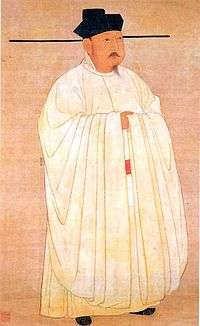 |
Taizong (太宗; Tàizōng) | too long; not used when referring to this sovereign | Zhao Jiong (趙炅; Zhào Jiǒng) | 976–997 | |
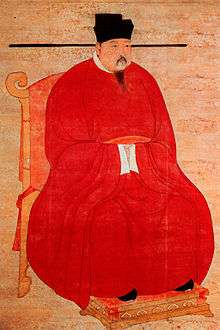 |
Zhenzong (真宗; Zhēnzōng) | too long; not used when referring to this sovereign | Zhao Heng (趙恆; Zhào Héng) | 997–1022 | |
 |
Renzong (仁宗; Rénzōng) | too long; not used when referring to this sovereign | Zhao Zhen (趙禎; Zhào Zhēn) | 1022–1063 |
|
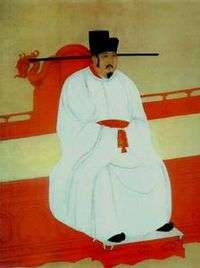 |
Yingzong (英宗; Yīngzōng) | too long; not used when referring to this sovereign | Zhao Shu (趙曙; Zhào Shǔ) | 1063–1067 |
|
 |
Shenzong (神宗; Shénzōng) | too long; not used when referring to this sovereign | Zhao Xu (趙頊; Zhào Xū) | 1067–1085 | |
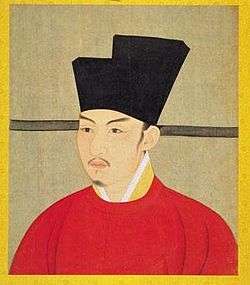 |
Zhezong (哲宗; Zhézōng) | too long; not used when referring to this sovereign | Zhao Xu (趙煦; Zhào Xù) | 1085–1100 | |
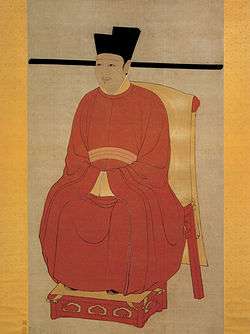 |
Huizong (徽宗; Huīzōng) | too long; not used when referring to this sovereign | Zhao Ji (趙佶; Zhào Jí) | 1100–1125 | |
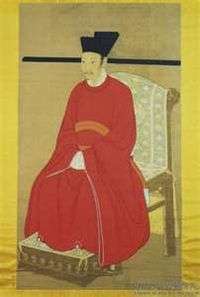 |
Qinzong (欽宗; Qīnzōng) | too long; not used when referring to this sovereign | Zhao Huan (趙桓; Zhào Huán) | 1126–1127 |
|
Southern Song, 1127–1279
| Portrait | Temple names (廟號; miào hào) |
Posthumous names (諡號; shì hào) |
Birth names | Period of reigns |
Era names (年號; nián hào) and their according range of years |
|---|---|---|---|---|---|
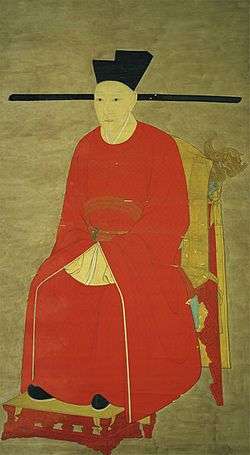 |
Gaozong (高宗; Gāozōng) | Shòumìng Zhōngxīng Quángōng Zhìdé Shèngshén Wǔwén Zhāorén Xiànxiào Huángdì (受命中興全功至德聖神武文昭仁憲孝皇帝) | Zhao Gou (趙構; Zhào Gòu) | 1127–1162 | |
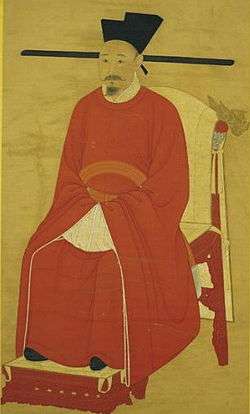 |
Xiaozong (孝宗; Xiàozōng) | Shàotǒng Tóngdào Guāndé Zhāogōng Zhéwén Shénwǔ Míngshèng Chéngxiào Huángdì (紹統同道冠德昭功哲文神武明聖成孝皇帝) | Zhao Shen (趙昚; Zhào Shèn) | 1162–1189 | |
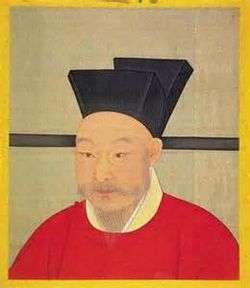 |
Guangzong (光宗; Guāngzōng) | Xúndào Xiànrén Mínggōng Màodé Wēnshùn Wǔshèng Zhécí Xiào Huángdì (循道憲仁明功茂德溫文順武聖哲慈孝皇帝) | Zhao Dun (趙惇; Zhào Dūn) | 1189–1194 |
|
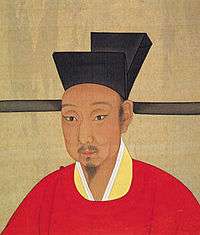 |
Ningzong (寧宗; Níngzōng) | Fǎtiān Bèidào Chúnquán Démào Gōngrén Wénzhé Wǔshèng Ruìgōng Xiào Huángdì (法天備道純德茂功仁文哲武聖睿恭孝皇帝) | Zhao Kuo (趙擴; Zhào Kuò) | 1194–1224 | |
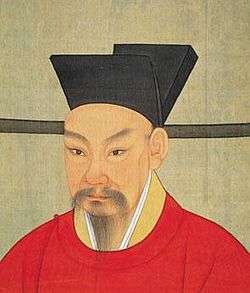 |
Lizong (理宗; Lǐzōng) | Jiàndào Bèidé Dàgōng Fùxīng Lièwén Rénwǔ Shèngmíng Ānxiào Huángdì (建道備德大功復興烈文仁武聖明安孝皇帝) | Zhao Yun (趙昀; Zhào Yún) | 1224–1264 | |
 |
Duzong (度宗; Dùzōng) | Duānwén Míngwǔ Jǐngxiào Huángdì (端文明武景孝皇帝) | Zhao Qi (趙祺; Zhào Qí) | 1264–1274 |
|
 |
Gong (恭; Gōng) | Xiàogōng Yìshèng Huángdì (孝恭懿圣皇帝) | Zhao Xian (趙顯; Zhào Xiǎn) | 1275 |
|
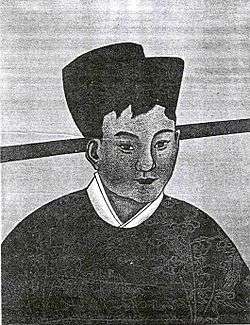 |
Duanzong (端宗; Duānzōng) | Yùwén Zhāowǔ Mǐnxiào Huángdì (裕文昭武愍孝皇帝) | Zhao Shi (趙昰; Zhào Shì) | 1276–1278 |
|
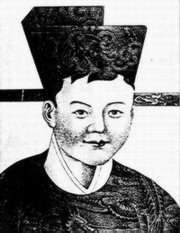 |
Huaizong (懷宗; Huáizōng) | Gōngwén Níngwǔ Āixiào Huángdì (恭文寧武哀孝皇帝) | Zhao Bing (趙昺; Zhào Bǐng) | 1278–1279 |
|
Family tree of emperors
Notes
- ↑ Convention: "Sòng" + temple name or posthumous name except last emperor who was revered as "Song Di Bing" (宋帝昺; Sòng Dì Bǐng)
- ↑ See the "names and titles" section of this article for an explanation.
Footnotes
- 1 2 Mote (1999), pp. 98–99.
- 1 2 Bol (2001), p. 112.
- ↑ Hennessey (1984), pp. 42, 51.
- ↑ Ebrey et al. (2006), pp. 165–167.
- ↑ Gernet (1962), p. 22.
- ↑ Coblin (2002), p. 533.
- ↑ Tillman (1995), p. 29; Mostern (2008), p. 241.
- ↑ Rossabi (1988), pp. 8, 53.
- ↑ Rossabi (1988), pp. 93–94.
- ↑ David C. Wright (2012). David Andrew Graff; Robin D. S. Higham, eds. A Military History of China. University Press of Kentucky. p. 73. ISBN 978-0-8131-3584-7.
- ↑ Wilkinson (1998), p. 106; Mote (1999), p. 98.
- 1 2 3 4 5 Wilkinson (1998), p. 106.
- ↑ Wilkinson (1998), pp. 106–107.
- ↑ Wilkinson (1998), p. 107.
- ↑ Bol (2001), pp. 113–114.
- ↑ de Crespigny (2007), pp. 1216, 1226–1228; Bielenstein (1980), pp. 84–85, 143–144; Hucker (1975), pp. 149–150; Wang (1949), pp. 157–158, 173–177.
- ↑ Ebrey et al. (2006), p. 159–160; Bol (2001), p. 107; Gernet (1962), p. 65.
- ↑ Mote (1999), pp. 99–100.
- ↑ Ebrey (1999), pp. 145–146.
- ↑ Bol (2001), 132.
- 1 2 3 See Bol (2001), pp. 103–134 for detailed analysis.
- ↑ Hartwell (1982), pp. 405–407.
- ↑ Ebrey (1999), pp. 145–146; Mote (1999), p. 102; see also Needham (1972), p. 132.
- ↑ Yuan (1994), pp. 196–194; Bol (2001), pp. 115–116, 121, 133; see also Ebrey (1999), pp. 145–146.
- ↑ Hartwell (1982), pp. 413–416.
- ↑ Bol (2001), 116.
- ↑ Hymes (1986), pp. 132–133; Walton (1999), p. 199.
- ↑ Bol (2001), p. 133.
- ↑ Mote (1999), p. 100.
- ↑ Mote (1999), p. 101.
- ↑ Bo (1977), pp. 873–876.
- ↑ Bo (1977), pp. 876–878.
- ↑ Bo (1977), pp. 878–881.
- ↑ Bo (1977), pp. 881–883.
- ↑ Bo (1977), pp. 883–885.
- ↑ Bo (1977), pp. 885–886.
- ↑ Bo (1977), pp. 886–887.
- ↑ Bo (1977), p. 887.
- ↑ Bo (1977), pp. 887–891.
- ↑ Bo (1977), pp. 891–892.
- ↑ Bo (1977), pp. 892–894.
- ↑ Bo (1977), pp. 894–895.
- ↑ Bo (1977), p. 895.
- ↑ Bo (1977), pp. 895–896.
- ↑ Bo (1977), pp. 896–897.
- ↑ Bo (1977), pp. 897–898.
- ↑ Bo (1977), p. 898.
- ↑ Bo (1977), pp. 898–899.
- ↑ Bo (1977), pp. 899–903.
- ↑ Bo (1977), pp. 903–904.
- ↑ Bo (1977), p. 905.
- ↑ Bo, pp. 905–907.
- ↑ Bo (1977), pp. 908–909.
- ↑ Bo (1977), pp. 909–914.
- ↑ Bo (1977), pp. 914–918.
- ↑ Bo (1977), pp. 918–921.
- ↑ Bo (1977), pp. 921–923.
- ↑ Bo (1977), pp. 923–924.
- ↑ Bo (1977), p. 927.
- ↑ Bo (1977), pp. 927–928.
- ↑ Bo (1977), pp. 928–929.
- ↑ Bo (1977), pp. 929–931.
- ↑ Bo (1977), p. 931.
- ↑ Bo (1977), pp. 932–935.
- ↑ Bo (1977), pp. 937–938.
- ↑ Bo (1977), pp. 938–942.
- ↑ In 1129, Emperor Gaozong was briefly forced to abdicate in favour of his two-year-old son Zhao Fu, with the era name Mingshou, but as shortly after Emperor Gaozong was restored by forces loyal to him, Zhao Fu is not usually considered a Song emperor by traditional historians, nor was his era name recognised. But see Bo (1977), pp. 941–942.
- ↑ Bo (1977), pp. 944–961.
- ↑ Bo (1977), pp. 961–962.
- ↑ Bo (1977), pp. 963–965.
- ↑ Bo (1977), pp. 965–969.
- ↑ Bo (1977), pp. 970–972.
- ↑ Bo (1977), pp. 972–973.
- ↑ Bo (1977), pp. 977–978.
- ↑ Bo (1977), pp. 979–981.
- ↑ Bo (1977), pp. 981–988.
- ↑ Bo (1977), pp. 989–990.
- ↑ Bo (1977), pp. 991–994.
- ↑ Bo (1977), pp. 995–996.
- ↑ Bo (1977), pp. 996–997.
- ↑ Bo (1977), pp. 998–1002.
- ↑ Bo (1977), pp. 1003–1004.
- ↑ Bo (1977), p. 1005.
- ↑ Bo (1977), pp. 1006–1008.
- ↑ Bo (1977), pp. 1008–1011.
- ↑ Bo (1977), pp. 1012–1013.
- ↑ Bo (1977), pp. 1013–1015.
- ↑ Bo (1977), pp. 1015–1016.
References
- Bielenstein, Hans (1980). The Bureaucracy of Han Times. Cambridge: Cambridge University Press. ISBN 0-521-22510-8.
- Bo Yang (1977). Timeline of Chinese History 中國歷史年表. Taipei: Sing-Kuang Book Company Ltd.
- Bol, Peter K. (2001). "Whither the Emperor? Emperor Huizong, the New Policies, and the Tang-Song Transition". Journal of Song and Yuan Studies. 31: 103–134. JSTOR 23496091.
- Coblin, W. South (2002). "Migration History and Dialect Development in the Lower Yangtze Watershed". Bulletin of the School of Oriental and African Studies. 65 (3): 529–543. doi:10.1017/S0041977X02000320. JSTOR 4146032.
- de Crespigny, Rafe (2007) [23–220 AD]. A Biographical Dictionary of Later Han to the Three Kingdoms. Leiden: Koninklijke Brill. ISBN 90-04-15605-4.
- Ebrey, Patricia Buckley (1999). The Cambridge Illustrated History of China (paperback). Cambridge: Cambridge University Press. ISBN 0-521-66991-X.
- Ebrey, Patricia; Walthall, Anne; Palais, James (2006). East Asia: A Cultural, Social, and Political History. Boston: Houghton Mifflin Company. ISBN 0-618-13384-4.
- Gernet, Jacques (1962). Daily Life in China on the Eve of the Mongol Invasion, 1250–1276. Stanford: Stanford University Press. ISBN 0-8047-0720-0.
- Hartwell, Robert M. (1982). "Demographic, Political, and Social Transformations of China, 750–1550". Harvard Journal of Asiatic Studies. 42 (2): 365–442. JSTOR 2718941.
- Hennessey, William O. (July 1984). "Classical Sources and Vernacular Resources in "Xuanhe Yishi": The Presence of Priority and the Priority of Presence". Chinese Literature: Essays, Articles, Reviews. CLEAR. 6 (1/2): 33–52. JSTOR 823445.
- Hucker, Charles O. (1975). China's Imperial Past: An Introduction to Chinese History and Culture. Stanford: Stanford University Press. ISBN 0-8047-0887-8.
- Hymes, Robert P. (1986). Statesmen and Gentlemen: The Elite of Fu-Chou, Chiang-Hsi, in Northern and Southern Sung. Cambridge: Cambridge University Press. ISBN 0-521-30631-0.
- Mostern, Ruth (2008). "From Battlefields to Counties: War, Border, and State Power in Southern Song Huainan". In Wyatt, Don J. Battlefronts Real and Imagined: War, Border, and Identity in the Chinese Middle Period. New York: Palgrave MacMillan. pp. 227–252. ISBN 978-1-4039-6084-9.
- Mote, Frederick W. (1999). Imperial China: 900–1800. Cambridge: Harvard University Press. ISBN 0-674-01212-7.
- Needham, Joseph (1972). Science and Civilization in China: Volume 1, Introductory Orientations. London: Syndics of the Cambridge University Press. ISBN 0-521-05799-X.
- Rossabi, Morris (1988). Khubilai Khan: His Life and Times. Berkeley, Los Angeles, London: University of California Press. ISBN 0520067401.
- Tillman, Hoyt C.; West, Stephen H. (1995). China Under Jurchen Rule: Essays on Chin Intellectual and Cultural History. Albany: State University of New York Press. ISBN 0-7914-2273-9.
- Walton, Linda (1999). Academies and Society in Southern Sung China. Honolulu: University of Hawaii Press. ISBN 0824819624. JSTOR 3558593.
- Wang, Yu-ch'uan (June 1949). "An Outline of The Central Government of The Former Han Dynasty". Harvard Journal of Asiatic Studies. 12 (1/2): 134–187. JSTOR 2718206.
- Wilkinson, Endymion (1998). Chinese History: A Manual. Cambridge and London: Harvard University Asia Center of the Harvard University Press. ISBN 0-674-12378-6.
- Yuan, Zheng (Summer 1994). "Local Government Schools in Sung China: A Reassessment". History of Education Quarterly. 34 (2): 193–213. JSTOR 369121.
External links
| Wikimedia Commons has media related to Portraits of Emperors of the Song Dynasty. |
 Media related to Song Dynasty at Wikimedia Commons
Media related to Song Dynasty at Wikimedia Commons- Chinese History - Song Dynasty 宋 (960–1279), emperors and rulers (www.chinaknowledge.de)